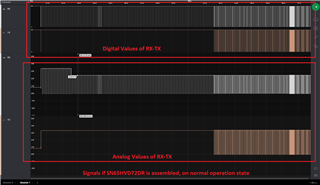Hello,
About 4 months ago I stated our problem about the manufacturer using SN65HVD3082ED instead of SN65HVD72DR in the below linked thread
If I need to give more details about our product, the product is a thermostat and there is two different modes which are steady-state mode and normal operation mode. If the device is in steady-state mode before power restart, it starts on steady-state mode. But if the device is on normal operation mode before power restart, it starts in normal operation mode. On steady-state mode the device just shows the temperature on the display and turns off the fancoil controls.
To summarize a customer of us made a complaint about our products saying they are not communicating. After examining the products we have in the warehouse, we realized our manufacturer have been using SN65HVD3082ED instead of SN65HVD72DR. The problem is on the datasheet of SN65HVD3082ED it is stated that the IC should be supplied by 5V. But our circuit design have been supplied by 3.3V (You can see circuit design at the attachment). So naturally we thought the problem is caused by the wrong supplying voltage. After that we tried to do tests in the office environment.. As we discussed in the other thread linked above after adding 36 device in the line the communication fails, there is no problem here. But our customer said even if there is 15 devices in the line the communication fails.
After our customer feedback one of our field engineers visited the field and saw that if the device starts working in steady-state mode there would be no communication and if the device started to working in normal operation mode there would be no problem in the communication. The field engineer brought one of the devices so we examined it.
We examined the product brought from the field communicating with it peer to peer. As you can see in the attached images (yellow-receive signal, blue-transmit signal, pink-enable signal) the signals are peculiar. When there is no communication, receive signal voltage level starts 3.3V voltage level but after 1 second drops around 1V and it seems this is the reason why the communication fails. Even if there is a data, since the voltage level is around 1V MCU can not identify it as a data and starts sending a garbage data. You can see there is no problem with transmit data voltage level.
We can not see this problem when testing the products we have in the warehouse so we thought the products being damaged in the field. But we can not understand the situation. Why would there be no problem if the device starts on normal operation mode but just when it starts on steady state mode? Is this even possible for the IC to behave differently when there is no change in the supply voltage?
I wanted to fully explain the situation, sorry for the long explanation.
Note: The baudrate is 76800kbps.









